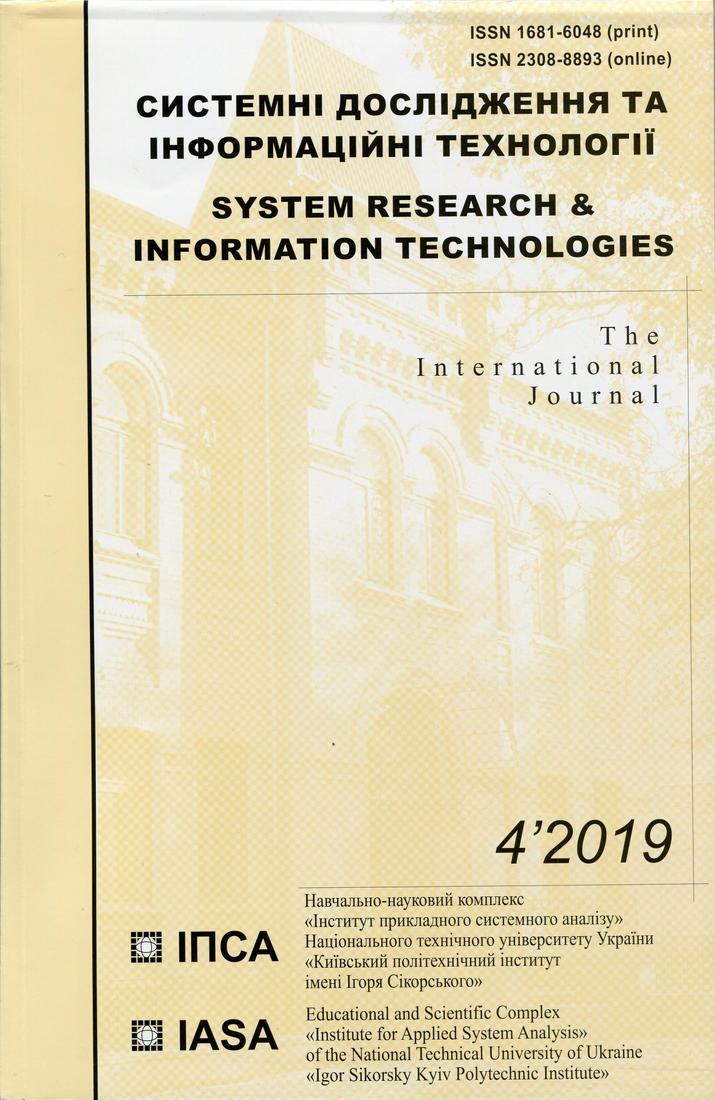Investigating adequacy of interval type-2 fuzzy models in complex objects identification problems
DOI:
https://doi.org/10.20535/SRIT.2308-8893.2019.4.10Keywords:
type-2 fuzzy model, interval membership function, information identity measureAbstract
A method of building a set of type-2 fuzzy models with interval membership functions is proposed. The resulting set possesses the ability to generalize final results and is supported by experimental results. A procedure of generalizing interval outputs of fuzzy models from the obtained set is proposed. Apart from all the advantages of building fuzzy models based on experimental data, the proposed approach allows to account for multiple experts’ opinions, and based on that, to perform the correction of the input vector data. The final result is presented as an interval. Based on the interval’s width, it is possible to make conclusions on how adequately the model reflects the subject area. Using experimental research related to a practical problem of evaluating of how promising an artesian well is, it is shown that based on the obtained interval, that generalizes results of all models’ operation, it is possible to find an output value that would be satisfactory for solving the presented problem.References
Liang Q. Interval Type-2 fuzzy logic systems: theory and design / Q. Liang, J.M. Mendel // IEEE Transactions on Fuzzy Systems. — 2000. — Vol. 8. — P. 535–550.
Zajchenko Ju.P. Nechetkie modeli i metody v intellektual'nyh sistemah / Ju.P. Zajchenko. — K.: Izdat. dom "Slovo", 2008. – 344 s.
Mendel J.M. Interval Type-2 Fuzzy logic systems made simple / J.M. Mendel, R.I. John // IEEE Transactions on Fuzzy Systems. — 2006. — Vol. 14, N 6. — P. 808–821.
Kondratenko N.R. Henetychne nastrojuvannja nechitkoyi modeli v zadachi diahnostyky hipotyreozu / N.R. Kondratenko, S.M. Kuzemko // Visnyk VPI. — 2003. — №6. – S.278–283.
Kondratenko N.R. Interval'ni nechitki modeli typu-2 v zadachakh identyfikatsiyi ob’yektiv z bahat'ma vkhodamy ta vykhodamy / N.R. Kondratenko, O.V. Cheboraka, O.A. Tkachuk // Systemy obrobky informatsiyi. — 2011. — № 3(93). — S. 48–52.
Saima H. ARIMA based Interval Type-2 Model for Forecasting / H. Saima, J. Jaafar, S. Belhaouari, T.A. Jillani // International Journal of Computer Applications. — 2011. — Vol. 28, N 3. — P. 17–21.
Khanesar M.A. Extended Kalman Filter Based Learning Algorithm for Type-2 Fuzzy Logic Systems and its Experimental Evaluation / M.A. Khanesar, E. Kayacan, M. Teshnehlab, O. Kaynak // IEEE Transactions on Industrial Electronic. — 2012. — Vol. 59, N 11. — P. 4443–4455.
Melin P. An intelleigent hybrid approach for industrial quality control combining neural networks, fuzzy logic and fractal theory / P. Melin, O. Castillo // Information Sciences. — 2007. — Vol. 147, N. 177. — P. 1543–1557.
Kondratenko N.R. Doslidzhennja mozhlyvostej uzahal'njuval'noyi interval'noyi typu-2 nechitkoyi modeli dlja prohnozuvannja chasovykh poslidovnostej / N.R. Kondratenko, O.V. Cheboraka // Visnyk VPI. — 2008. — №6. — S. 22–27.
Kondratenko N. Interval Fuzzy Modeling of Comlex Systems under Conditions of Input Data Uncertainly / N. Kondratenko, O. Snihur // Eastern-European Journal of Enterprise Technologies. — 2016. — Vol. 4/4 (82). — P. 20–28.
Kondratenko N.R. Pidvyshchennja adekvatnosti nechitkykh modelej za rakhunok vykorystannja nechitkykh mnozhyn typu 2 / N.R. Kondratenko // Naukovi visti NTUU "KPI". — 2014. — № 6. — S. 56–61.
Kondratenko N.R. Nechitki lohichni systemy z vrakhuvannjam propuskiv v eksperymental'nykh danykh / N.R. Kondratenko, N.B. Zelins'ka, S.M. Kuzemko // Naukovi visti NTUU "KPI". — 2004. — № 5. — S. 37–41.

